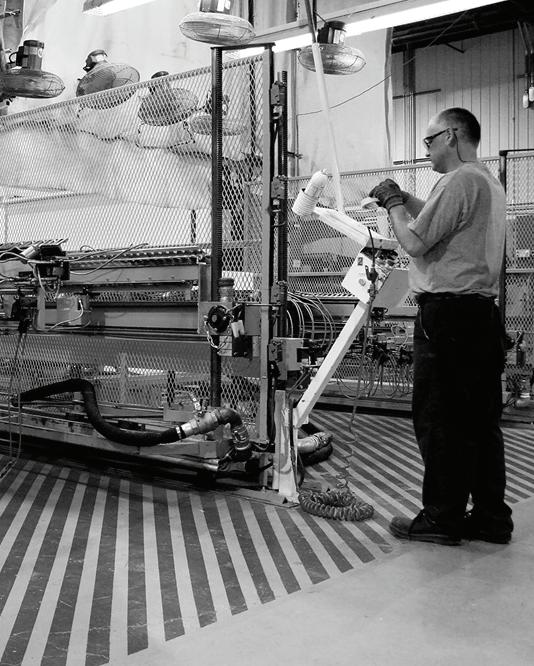
12 minute read
Introduction to Employee Engagement
part 1 | chapter 1
IntroduCtIon to employee engagement
Advertisement
As a company, ABG is focusing on creating excellent Customer Experiences for both our internal and external customers . Creating excellent experiences for our internal customers, which are our team members and members from other teams within ABG, is just as important as creating excellent Customer Experiences for our external customers . Our internal customers, or our teammates and members of other teams, are responsible for the success of our day-today operations, for creating wins and achieving goals, and ultimately creating the success of us as a company . In order for the team that you lead to be successful and contribute to us winning as a company, team members have to execute their job with passion, drive, discipline, and dedication .
Team members who do excellent work and are passionate, driven and dedicated to what they do are what we would call “engaged” . Engaged team members work harder, stay longer, ask what they can do better, and overall contribute more to the success of the team in comparison to disengaged team members .
At the American Bath Group, our desire is to be excellent and we are in the constant pursuit of achieving that excellence . In order for us to be excellent, the team you lead and the members that make up that team must be excellent . If you, as a leader, have highly engaged team members, you and your team will perform excellently which will greatly contribute to your team winning as well as us winning as a company . If you don’t have engaged team members, then your team won’t perform excellently, and ABG will not achieve excellence .
that leads us to our fIrst questIon. What exaCtly Is employee engagement (ee)?
employee engagement defIned
engagement is a state of being of employees that is characterized by the discretionary use of their mental and emotional energy which is exhibited through their on-the-job behaviors . These behaviors of engagement result from maximizing the levels of antecedent factors of engagement .
In other words, engagement is when employees show more interest, passion, drive, and give extra on the job because factors in our workplace that increase employee engagement, such as team members getting positive feedback from their manager or being publicly celebrated for their excellent work, are being used effectively by the leaders in our organization .

busIness ImpaCt
Is employee engagement a bIg deal? It absolutely Is.
So, what is the impact of Employee Engagement? Well, Employee Engagement is central to our success as a company . Employees who are engaged are easier to work with, show passion in their job, are motivated, strive for more, handle stress better, interact better with other team members, and perform better overall . Unfortunately, 87% of all employees across industries are not engaged in their work . Yet, companies with highly engaged employees outperform competitors by 147% (Gallup, 2017) . These numbers demonstrate that the business impact of having engaged employees is enormous . However, if 87% of employees across all industries are not engaged, then American Bath Group’s employee base is likely similar in levels of engagement . This means that as leaders, continued pursuit of engaging your teams is a core responsibility of your leadership position .
responsIbIlIty
Given the impact engagement creates, it is essential that we, as leaders, focus our efforts on creating engaged employees . As leaders, it is your core responsibility to ensure that your team members are engaged . If they are not, it is your responsibility to understand why they aren’t and create positive change . In your role, you take on a responsibility for the successes and the failures of your team . A substantial part of the success of your team is dependent on how engaged your team members are . If you’re turnover rate and absenteeism is high, and engagement scores low, it is your responsibility to figure out what is going wrong and implement ways to engage your team . Engagement is a leadership responsibility .
so hoW do We do engage our team members? 87%
Employees not engaged in their work
Highly engaged employees outperform competitors
147%

fIrst, thInk about thIs.
You have been to or at least seen popular restaurants . The line is long, and the wait is much longer than you would experience at other places . In the end, people just want food…right? Not exactly . People want food, but they also want much more . They want a nice setting . They want good choices . They want excellent service . They want to be part of something that is considered a good thing . They want to be paid attention to . They want the right lighting . They want high quality food that satisfies . They want a clean and inviting environment that makes them feel comfortable and welcomed . They want reasonable prices . They want their order to be right . And, they want their order in a timely manner so they can get on with their day .
Employee Engagement is much like this . It is about creating a setting where so many of the things that are important to people exists . It is about creating a setting where (1) a person feels they make a difference – their work and effort matters . It is about (2) feeling fair treatment exists . It is about (3) feeling pride in the work product that is being created . It is about (4) getting recognition for a job well done . It is about (5) being part of a team . It is about (6) seeing areas of opportunity for oneself if the desire exists . It is about (7) personal growth . It is about (8) knowing that when things don’t go right, coaching and encouragement will occur . It is about (9) being involved, (10) helping solve problems, and (11) having your opinion asked .
For a leader to be strong at engaging their employees, they have to be trained to recognize and understand the importance of the previously listed items . They also have to be trained to understand how their role creates and largely influences the existence of these items within their area and ultimately, within the company . Generally, for the American Bath Group, the focus is around showing leaders how to care and demonstrating their care to the people they lead and work with .
01
________________________________
Feeling they make difference
their work and effort matters
02
________________________________ Feeling fair treatment exists
03
________________________________
Feeling pride
in work product that is being created
04
________________________________
Getting recognition
for a job well done
05
________________________________
Being part of a team
06
________________________________
Seeing areas of opportunity
for oneself if the desire exists
07
________________________________
Personal growth
08
________________________________
Coaching and encouragement
when things don’t go right
09
________________________________
Being involved
10
________________________________
Helping solve problems
11
________________________________
Having your opinion asked
shoWIng you Care
At the American Bath Group, showing that you care is something we refer to as stickies . Stickies create an emotional bond or emotional “stickiness” between a leader and their team members . Stickies are created when we show a genuine interest in and genuine care for our people . Stickies can be created through having non-workrelated conversations where you, as a leader, ask your team members how things are going outside of work, how their families are, or how their sick relative is recovering . Stickies can be created when you coach and mentor your team members because this shows a genuine interest, care, and investment in your people . Stickies can be created by walking the floor, smiling, talking to your employees, asking questions, having discussions, celebrating wins, etc . Stickies can be created between you and your team members any time you show genuine interest and care in them, regardless of the method . So, get creative and be genuine about it .
When your team members can see through your words and actions that you have a genuine interest in them and care for them, they will give you extra on-the-job effort and go above and beyond for you when needed . Employees that feel a strong connection with their leaders are more engaged in their work, so they do higher quality work at a more efficient pace .
In order to gain the hearts of our people and engage them, we must show we care, and we must put extensive effort into the demonstrating this care to all of those we work with every day .

ee starts from the begInnIng
Engaging your team is an on-going process that starts from Day 1 on an employee’s journey with us at the American Bath Group . When an employee first arrives at ABG they will be both excited and uncertain of what to expect . Uncertainty in our new team members can either be turned into a negative experience that causes anxiety and disengagement, or it can be turned into a positive experience that starts to form engagement within our new team members . So, as leaders, how can we take our new team members and quickly get them comfortable with both their job, the people they work with, and you as their leader so that their level of engagement will increase from the start?
We can do this by:
• Making positive first impressions by smiling and asking the new team members how their day is going . • Giving new-hires a tour of the facility and familiarizing them with their surroundings on Day 1 . • Clearly defining and explaining the job, role, expectations, responsibilities, and providing clear and effective training to our new-hires . • Making regular follow-ups throughout the first day and through the first few weeks with your new team members to ensure that they are comfortable and have the tools and resources they need . Regular follow-ups with new team members should occur 3-4 times per day within the first couple of weeks . This will ensure that team members are comfortable, confident, and have what they need to be successful .
• Begin “stickies” with new team members from Day 1 .
Ask new team members a little bit about themselves and get to know them so they feel comfortable and begin making connections with other team members at work . • Compliment new team members often on their progress .
Celebrate the small wins frequently during the first few weeks .
• Take new team members out to lunch . • Introduce new team members to each person on their team and assign a buddy for the first few weeks . Hold the new-hire buddy accountable for sticking with the new-hire .
• Introduce new team members to all leaders .
• Hold a team lunch within the first couple of weeks . • Discuss who ABG is as a company to form an emotional bond and show new team members the values and vision of the awesome company we work for (ABG mission, vision, Core Drivers, Origins Story, Leadership
Highlight stories, ABG Core Cultural Values) . For more suggestions and methods of on-boarding employees and increasing engagement during the on-boarding process, please refer to our Employee Engagement Handbook and our On-Boarding Training Video .


faCtors of employee engagement
Now that we have discussed the most important part of Employee Engagement – showing that you genuinely care for and have a genuine interest in your team members, as well as the fact that employee engagement starts from Day 1 and that it is extremely important to engage our team members during this time because this critical time period is where they will decide to either buy-in to and engage in working at ABG or they will disengage and likely quit – let’s now discuss other ways to create positive change in engagement levels within our teams . But before we do that, let makes sure that we have a clear understanding of what Employee Engagement is and how to best think about it .
hoW to best understand employee engagement
Employee engagement, like any other idea used to help us understand why things are a certain way in human behavior, can be best understood by the factors that affect engagement levels, also known as antecedent factors .
What does this mean? It means that certain actions and events that happen in the workplace, such as team members receiving positive feedback from you, their leader, or being publicly recognized for their excellent work, help to either increase or decrease engagement levels within our teams . So, if we understand what actions and events, or factors, affect engagement levels, then we can make sure that we are positively influencing each of those factors and ensuring higher levels of engagement with our teams . If it’s still unclear, think of it this way . In our operating facilities, if a problem occurs, we may have a Kaizen event or a problem-solving meeting to determine the causes of the issue . Let’s say we use a fish-bone diagram to help us solve the problem . On our fish-bone diagram we would list out all the potential causes of the problem to then determine the root cause . So, if we know that shift changes, poor training, and poor processes creating excess waste are causing the issue seen in the plant, then we can work our way towards a solution .
In the same light, if we want to understand how we can best create the setting for our team members that will engage them, we must first define the factors that affect engagement levels within our team members (the causes on our fish-bone diagram), so that we can then form a clear picture of what it takes to create engagement within our teams, as well as to help solve engagement problems when engagement is low .
This leads us to our discussion of what factors affect employee engagement levels .
There are 10 Primary Factors that affect Employee Engagement levels . We will address each of these 10 factors as well as give suggestions for you, as leaders, on how you can positively influence each of these factors and ultimately increase engagement levels within your teams .










